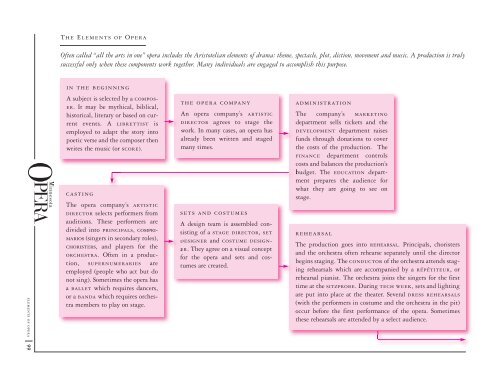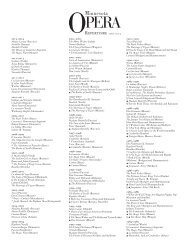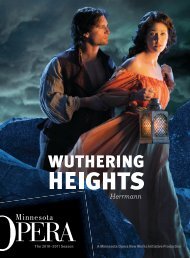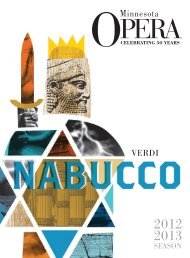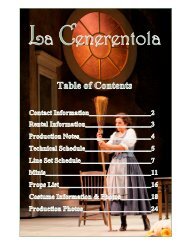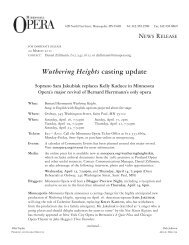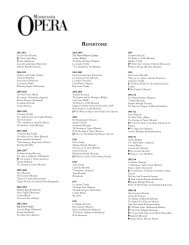You also want an ePaper? Increase the reach of your titles
YUMPU automatically turns print PDFs into web optimized ePapers that Google loves.
The Elements of <strong>Opera</strong><br />
Often called “all the arts in one” opera includes the Aristotelian elements of drama: theme, spectacle, plot, diction, movement and music. A production is truly<br />
successful only when these components work together. Many individuals are engaged to accomplish this purpose.<br />
in the beginning<br />
elements of opera 99<br />
A subject is selected by a composer.<br />
It may be mythical, biblical,<br />
historical, literary or based on current<br />
events. A librettist is<br />
employed to adapt the story into<br />
poetic verse and the composer then<br />
writes the music (or score).<br />
casting<br />
The opera company’s artistic<br />
director selects performers from<br />
auditions. These performers are<br />
divided into principals, comprimarios<br />
(singers in secondary roles),<br />
choristers, and players for the<br />
orchestra. Often in a production,<br />
supernumeraries are<br />
employed (people who act but do<br />
not sing). Sometimes the opera has<br />
a ballet which requires dancers,<br />
or a banda which requires orchestra<br />
members to play on stage.<br />
the opera company<br />
An opera company’s artistic<br />
director agrees to stage the<br />
work. In many cases, an opera has<br />
already been written and staged<br />
many times.<br />
sets and costumes<br />
A design team is assembled consisting<br />
of a stage director, set<br />
designer and costume designer.<br />
They agree on a visual concept<br />
for the opera and sets and costumes<br />
are created.<br />
administration<br />
The company’s marketing<br />
department sells tickets and the<br />
development department raises<br />
funds through donations to cover<br />
the costs of the production. The<br />
finance department controls<br />
costs and balances the production’s<br />
budget. The education department<br />
prepares the audience for<br />
what they are going to see on<br />
stage.<br />
rehearsal<br />
The production goes into rehearsal. Principals, choristers<br />
and the orchestra often rehearse separately until the director<br />
begins staging. The conductor of the orchestra attends staging<br />
rehearsals which are accompanied by a répétiteur, or<br />
rehearsal pianist. The orchestra joins the singers for the first<br />
time at the sitzprobe. During tech week, sets and lighting<br />
are put into place at the theater. Several dress rehearsals<br />
(with the performers in costume and the orchestra in the pit)<br />
occur before the first performance of the opera. Sometimes<br />
these rehearsals are attended by a select audience.


